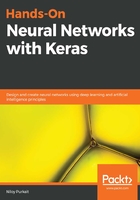
The nature of data processing
Earlier, we discussed how neurons may electrically propagate information and communicate with other neurons using chemical reactions. These same neurons help us determine what a cat or dog look like. But these neurons never actually see the full image of a cat. All they deal with is chemical and electric impulses. These networks of neurons can carry out their task only because of other sensory preprocessing organs, such as our eyes and optic nerve, that have prepared the data in an appropriate format for our neurons to be able to interpret. Our eyes take in the electromagnetic radiation (or light) that represents the image of a cat, and convert it into efficient representations thereof, communicated through electrical impulses. Hence, a prime difference between artificial and biological neurons relates to the medium of their intercommunication. As we saw, biological neurons use chemicals and electrical impulses as a means of communication. Similarly, artificial neurons rely on the universal language of mathematics to represent patterns from data. In fact, there exists a whole discipline surrounding the concept of representing real-world phenomena mathematically for the purpose of knowledge extraction. This discipline, as many of you are familiar with, is known as data science.